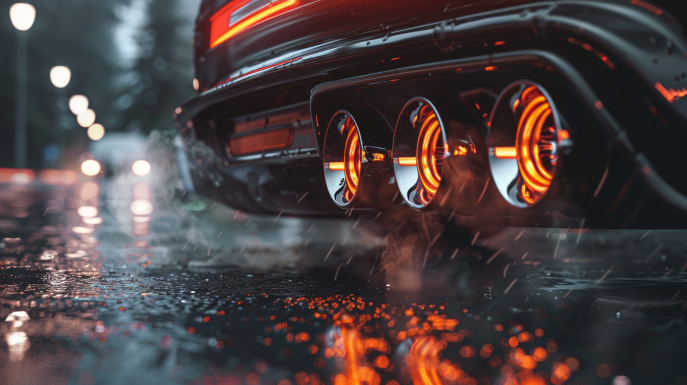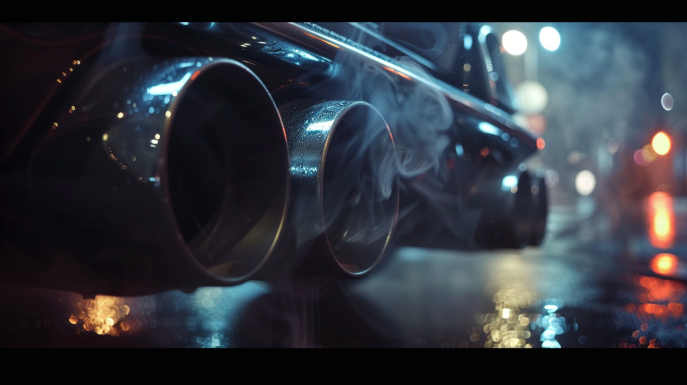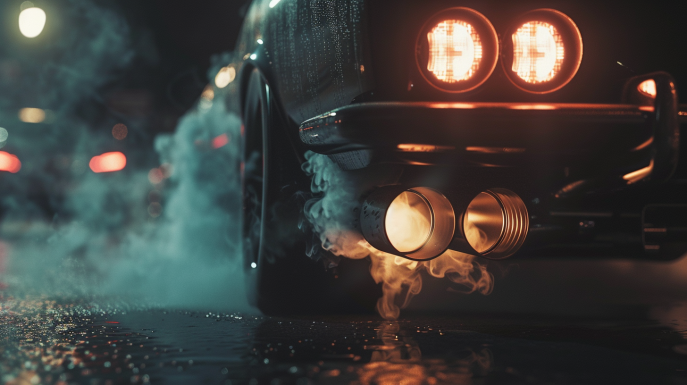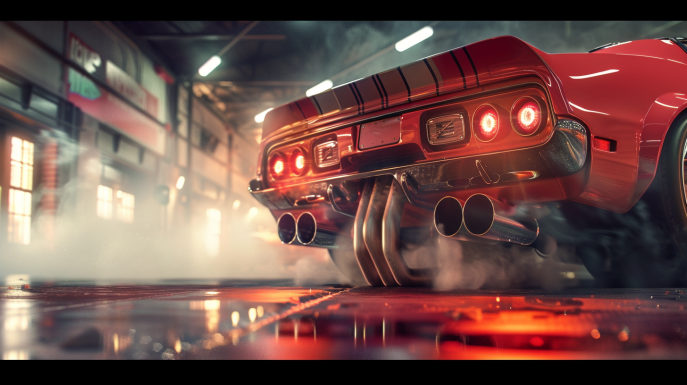Whether you drive a street rod, muscle car, truck, or even an SUV, adding an aftermarket performance muffler is one of the easiest ways to give your vehicle’s exhaust note a bit more aggressive tone. But when it comes to mufflers, you have a lot of choices. And for many auto enthusiasts looking to upgrade their exhaust system, it often comes down to the two most popular muffler series from Flowmaster: the Flowmaster 40 vs Flowmaster 44.
Both muffler series are designed to provide that deep, throaty rumble that any auto enthusiast craves, without being obnoxiously loud. Flowmaster is one of the most trusted names in aftermarket performance mufflers, known for quality construction and materials. But the 40 and 44 series do have some notable differences that might make one better suited for your particular vehicle and needs.
In this exhaust showdown guide, we’ll compare the Flowmaster 40 and 44 muffler series in all the key categories, including sound, performance, design, durability, fitment, price, and more. Let’s break down how these two Flowmaster heavy hitters stack up, so you can decide which one deserves a spot on your ride!
Sound Characteristics – Aggressive Tones from Both Mufflers

When choosing an aftermarket muffler, sound is likely your top priority. You want to hear that powerful, eye-catching rumble whenever you put your foot down. Both the Flowmaster 40 and Flowmaster 44 deliver on that promise of an aggressive exhaust tone. But each series does have its own sound characteristics:
- Flowmaster 40 – The 40 series uses a two-chamber interior design with a proprietary “deltatech” technology. This gives the Flowmaster 40 a deeper, more muscular sound compared to the 44. It really emphasizes the lower frequencies to give a commanding tone. The 40 has a moderate interior resonance that turns heads, without being overbearing within the cabin. It’s bold, but refined.
- Flowmaster 44 – The 44 series utilizes a three-chamber interior layout, which helps tune the sound. These mufflers have more of a raspy, higher-pitched tone that stands out. At high RPM or acceleration, the 44 has more of a screaming sound as the engine opens up, giving it a real “race car” vibe. The 44 definitely makes its presence known, yet still keeps an enjoyable exhaust note.
When fitted to the right application, both mufflers deliver an aggressive, powerful sound. The Flowmaster 40 highlights the deeper, beefy tones in an engine, while the 44 accentuates the higher-pitched side. See sound clips online to pick the intensity and pitch you prefer.
Performance Impact – Modest Gains, No Restriction
One concern when adding an aftermarket muffler is that it could restrict exhaust flow and thereby reduce power. Thankfully, both the Flowmaster 40 and 44 series are designed to provide great sound while maintaining free-flowing performance.
In fact, many dyno tests on unmodified, stock vehicles show modest gains in both horsepower and torque after installing Flowmaster mufflers. By improving exhaust tuning and reducing backpressure, you may see 1-3% increases.
Now, these are not the same gains you’d see from a full cat-back exhaust system upgrade. But for a simple muffler swap, a few extra horsepower is a nice bonus. And you can be confident the deep tone won’t come at the expense of lost performance.
When paired with other bolt-on mods like intake, headers, tuners, etc., either Flowmaster series will complement additional modifications without restriction. A free-flowing, uncorked exhaust helps realize the full benefit of engine upgrades.
Design and Construction – Durable, Heavy-Duty Parts

Flowmaster doesn’t cut corners when it comes to materials and construction quality. Both the 40 and 44 series feature tough, heavy-duty components built to last. This ruggedness is necessary to withstand years of use, vibration, temperature extremes, and more that an exhaust system endures.
Key design elements include:
- Fully MIG Welded Construction – Robotic welding ensures precise, clean welds at all seams. This prevents leaks and maintains strength.
- Stainless Steel or Aluminized Steel Materials – Corrosion-resistant metals withstand environmental damage. Some 409S stainless systems offer the best longevity.
- Thick Shells and Baffles – Durable housings and interior baffle plates control noise. Solid mounting brackets also prevent cracking.
- Mandrel-Bent Tubing – Maintains smooth exhaust flow and prevents power-robbing turbulence.
- High Temp Coatings – Either a ceramic black “Scatter Shield” coating or polished stainless finish protects from radiant header heat.
The overall construction quality is top-notch. And with good care and occasional cleaning, a Flowmaster muffler should last as long as you own the vehicle.
Sound Insulation – Minimal Resonance in Cabin
You want the deep, aggressive sound when you step on the gas. But when cruising, excessive drone or resonance inside the vehicle cabin can get annoying. Here’s how the Flowmaster 40 and 44 series compare in controlling interior noise:
- Flowmaster 40 – The two-chamber design with absorbent batting inside does an excellent job minimizing drone. Interior resonance is present but not overbearing. The tone doesn’t overwhelm normal conversation.
- Flowmaster 44 – With its higher-pitched tone, the 44 tend to carry a bit more interior resonance, especially on highway drives. The raspier tone has more potential for cabin drone. Proper exhaust tuning helps control it.
In either case, these Flowmaster mufflers maintain a livable interior environment for daily driving. Sound insulation in vehicles with factory laminated window glass also helps mute the exhaust note. Simply put, the 44 has a bit more “interior voice” than the 40 series.
Durability and Longevity – Built to Last for Years

We’ve already covered the sturdy construction. But how long can you expect a Flowmaster muffler to actually last on your vehicle?
- With proper installation and moderate driving, it’s not uncommon for a Flowmaster 40 or 44 muffler to last over 100,000+ miles. Some overland vehicles use Flowmaster mufflers on expedition-length trips half way around the world!
- Owners in northern climates subject to road salt report stainless steel Flowmaster mufflers outlasting factory mufflers by years.
- The galvanized, aluminized, or stainless steel materials withstand corrosion far better than stock mild steel mufflers.
- Even on race applications like drag cars, Flowmasters hold up to brief but intense use when properly warmed up.
- The main lifetime impacts are use severity (how hard you are on the vehicle), exposure to the elements, and the quality of installation. Any exhaust leaks can dramatically shorten lifespan.
Bottom line – with proper care and conditions, Flowmaster mufflers should outlast the expected lifetime of your vehicle!
Vehicle Fitment – Made for Most Popular Applications
Flowmaster manufactures each muffler series for precise fitment and coverage across the widest range of popular vehicles and exhaust configurations:
- Direct Fit Kits – Flowmaster offers hundreds of direct-fit kits, ensuring bolt-on compatibility with specific makes/models. This guarantees perfect fit and performance.
- Universal Fit Options – For custom applications, Flowmaster 40 and 44 series are available in universal inlet/outlet sizes and configurations to adapt to nearly any vehicle with a custom fabricated exhaust.
- Header Compatibility – Mufflers mate directly to Flowmaster headers or connector pipes. But inlet ports also match up with headers and downpipes from other brands as well.
- Complete Systems – In addition to mufflers alone, full cat-back exhaust system kits feature matched tubing and components for simple installation.
The wide range of inlet/outlet sizes and available configurations means Flowmaster mufflers work with small import 4-cylinder applications up to high-performance V8s. The brand is continually expanding applications to cover new makes/models as well.
Installation Process – DIY Friendly with Basic Skills

Here’s an overview of what’s involved to install Flowmaster mufflers on your car or truck:
- Time Commitment – Plan approximately 2-3 hours for a DIY muffler swap. This allows time for proper gasket seating and adjustment. Professional shops can often complete installation in 1-2 hours.
- Difficulty Level – With basic hand tools and DIY mechanical skills, it’s a relatively straightforward job. Just be patient and follow all joint torquing specifications. Direct bolt-on kits are simplest.
- Exhaust Modification – Mufflers bolt directly to existing head pipes or intermediate pipes in most applications. But if the existing system has rust or damage, sections may need replacement for proper fit.
- Joint Gaskets – Proper installation includes using new exhaust gaskets at all flanged connections to ensure an air-tight seal. This prevents leaks and maintains performance. High-temp copper gaskets are best.
- Angled Cutting – Cutting the existing system may be required to fit inlet and outlet pipes at the optimal angles for the new mufflers. A sawzall or hacksaw with metal cutting blades is usually needed.
- Hardware – Some applications require new clamps, brackets, or hangers for secure mounting. Using all high-quality included hardware ensures durability.
Overall, the process is very DIY friendly as long as you have jack stands, basic tools, and gaskets on hand. And you’ll save significant cost over professional installation.
Sound Clips and Videos – Hear the Difference Yourself
When trying to decide between the Flowmaster 40 vs 44 sound, there’s no substitute for actually listening to them yourself. Here are some great places to hear sound samples:
- YouTube Sound Clips – There are countless videos comparing the 40 and 44 side-by-side on various vehicles. This lets you hear real-world differences on engines you recognize.
- Flowmaster Website – The company provides audio samples of each series on their website for direct comparison. You can really pick up on the deeper vs. raspier tones.
- In Person – If possible, talking to local enthusiasts that have installed Flowmaster mufflers on their vehicles can be invaluable. This gives you a real-time impression of how they sound on the road.
- Dealer Showrooms – Some dealers may have vehicles equipped with Flowmasters that you can rev to sample their sound. This helps configure the exact system you’ll need.
Being able to listen first-hand makes it much easier to choose the tone and volume you want from either the 40 or 44 series Flowmasters. Seek out sound samples to make the most informed decision.
Price Comparison – Value Pricing on Improved Sound

Considering their construction quality and performance, Flowmaster mufflers deliver excellent value for your exhaust upgrade dollar:
- Flowmaster 40 – As the original, iconic Flowmaster sound, the 40 series carries a modest price premium. Retail prices range from about $130 on the low end, up to around $250+ for larger applications. Direct-fit kits for specific vehicles are most affordable.
- Flowmaster 44 – With stiffer competition in the 44 series market segment, these systems are a bit more value priced. Retail costs range from around $100 on the low end, up to about $220 for direct fit kits.
- In general, you should budget $150-250 for a complete Flowmaster 40 or 44 muffler system. Higher-end stainless steel versions or full cat-back exhaust kits cost more.
- Considering their durable construction and easy DIY installation, the price is definitely justified for the improved sound. No more bland stock exhaust note!
For a reasonable investment that transforms the character of your ride, Flowmaster mufflers deliver excellent value. And supporting a reputable brand like Flowmaster ensures quality components that should last the life of your vehicle.
Legal Compliance – 50-State Street Legal
A common concern is whether an aftermarket muffler might violate local noise regulations. Thankfully, both the Flowmaster 40 and 44 comply with the most stringent noise restrictions:
- All muffler components meet the 95 decibel limit for street legal use. Even with an aggressive tone, they stay within legal sound limits.
- Both series feature internal chambers and sound-absorbing materials to achieve compliance.
- Flowmaster mufflers meet 50-state emissions standards for street legal operation. This includes California Air Resources Board (CARB) compliance.
- They conform to all EPA and environment regulations on exhaust system design.
So you can enjoy the added performance sound safely with the peace of mind that your Flowmaster muffler meets emissions standards and noise levels for street-legal operation. Just don’t remove the mufflers entirely!
Sound Volume and Drone – Controlling Excess Noise

When selecting a muffler series, you also need to consider just how loud you want the exhaust tone to be:
- The Flowmaster 44 tends to be slightly louder externally than the 40 series. It highlights the higher-pitched tones that naturally carry farther.
- For loud exhaust fans, the 44 series better accentuates the aggressive sound. But it risks more interior resonance on highway cruising.
- The 40 series still delivers bold sound, but emphasizes the deeper muscle car rumble rather than all-out volume. This gives a refined boldness that’s more livable long-term.
- Proper exhaust system tuning can help control volume. Features like resonators, inlet tubes, and tip shape all modify the sound. The entire system should be optimized.
Overall, both Flowmaster series walk the line of sounding powerful yet controlled. Make sure to avoid drone or resonance becoming overwhelming on long drives. Test sound samples to find your ideal volume.
Recommended Uses – Everyday Driving to Racing
With their legendary sound and quality construction, Flowmaster mufflers work great for:
- Daily Drivers – The 40 series really shines here, delivering bold sound for basic commuting without excessive drone at highway speeds.
- Muscle Cars and Hot Rods – The Flowmaster tone epitomizes the classic American V8 rumble. Either series complements power upgrades.
- Trucks/SUVs – A Flowmaster vastly improves the weak exhaust note of most pickups or SUVs. The 44 gives an extra snarl.
- Off-Road/Overland – Rugged construction withstands off-road abuse. And the tone sounds right at home on lifted 4x4s.
- Race Vehicles – Flowmaster mufflers last longTerm even under race conditions. And reduced backpressure optimizes power.
They’re also popular for custom motorcycles, boats, RVs, and tractor pulls. In total, Flowmasters excel at giving an aggressive voice to virtually any engine. Pick the volume and tone you want.
Sound Customization – Modify as Needed
One great benefit of the Flowmaster design is you can further customize the sound:
- Adding a resonator helps reduce interior drone while maintaining an aggressive exterior tone. This improves livability in cabin.
- Larger inlet tubes or a less restrictive muffler creates more volume. Go smaller for a tighter, quieter sound.
- Play with outlet tip designs. Larger, slanted cut tips focus and amplify the sound compared to smaller outlets.
- Adjusting exhaust system length and tubing diameters also modifies the sound. Experiment to find your perfect pitch.
Pro tuners can adjust the exhaust setup to really dial-in your preferred tone. Don’t be afraid to tweak until it’s just right!
Brand Reputation and Quality – An Industry Leader

When you buy a Flowmaster muffler, you’re also investing in the proven reputation and quality assurance of an industry leader:
- Since 1983, Flowmaster has perfected the art of the high-performance street muffler. The 40 and 44 series represent decades of R&D and refinement.
- Founder Ray Flugger helped pioneer chambered, delta-flow muffler technology. The company holds multiple patents.
- Today, Flowmaster is one of the most respected names in aftermarket exhaust systems. Their mufflers are proven to deliver on their claims.
- All manufacturing and assembly takes place in the USA with rigorous quality control. This is not an offshore knock-off brand.
When it comes to aftermarket exhaust, no other brand has the legacy and reputation of Flowmaster. Their products come with the assurance of high-quality, track-tested development.
Choosing Your Flowmaster Sound – What’s Right for You?
So which series should you choose? Here’s a quick recap of the key differences:
- The Flowmaster 40 delivers a deep, mellow rumble – more refined and suitable for daily driving.
- The Flowmaster 44 provides an intense, raspy tone at higher RPMs – perfect for that “race car” sound.
- The 40 controls interior resonance better at highway speeds while the 44 turns up the overall volume.
- Both share rugged construction and performance benefits – you can’t go wrong either way!
Take some time to listen to various sound samples and decide which tone fits your personality and needs. With proper tuning, either Flowmaster series will reward you with years of bold, commanding exhaust presence. Your ride will never sound stock again. Ditch those bland OEM mufflers and feel the power of going Flowmaster!







